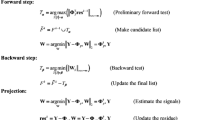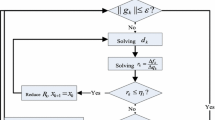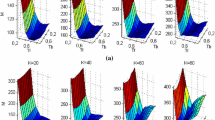Abstract
In this paper, we study a distributed compressed sensing (DCS) problem in which we need to recover a set of jointly sparse vectors from the measurements. A Backtracking-based Adaptive Orthogonal Matching Pursuit (BAOMP) method to approximately sparse solutions for DCS is proposed. It is an iterative approach where each iteration consists of consecutive forward selection to adaptively choose several atoms and backward removal stages to detect the previous chosen atoms’ reliability and then delete the unreliable atoms at each iteration. Also, unlike its several predecessors, the proposed method does not require the sparsity level to be known as a prior which makes it a potential candidate for many practical applications, when the sparsity of signals is not available. We demonstrate the reconstruction ability of the proposed algorithm on both synthetically generated data and image using Normal and Binary sparse signals, and the real-life electrocardiography (ECG) data, where the proposed method yields less reconstruction error and higher exact recovery rate than other existing DCS algorithms.









Similar content being viewed by others
References
Attar A, Shahbahrami A, Rad EM (2016) Image quality assessment using edge based features. Multimed Tools Appl 75(12):7407–7422
Baron D, Duarte MF, Wakin MB, Sarvotham S, Baraniuk RG (2009) Distributed compressed sensing. IEEE Transactions on Information Theory. http://dsp.rice.edu/publications/distributed-compressive-sensing
Berger C, Zhou S, Preisig J, Willett P (2010) Sparse channel estimation for multicarrier underwater acoustic communication: from subspace methods to compressed sensing. IEEE Trans Signal Process 58(3):1708–1721
Blanchard J, Cermak M, Hanle D, **g YR (2014) Greedy algorithms for joint sparse recovery. IEEE Trans Signal Process 62(7):1694–1704
Bruckstein AM, Donoho DL, Elad M (2009) From sparse solutions of systems of equations to sparse modeling of signals and images. SIAM Rev 51:34–81
Candes E, Tao T (2006) Near-optimal signal recovery from random projections: universal encoding strategies. IEEE Trans Inf Theory 52(12):5406–5425
Dai W, Milenkovic O (2009) Subspace pursuit for compressive sensing signal reconstruction. IEEE Trans Inf Theory 55(5):2230–2249
Do TT, Gan L, Nguyen N, Tran TD (2008) Sparsity adaptive matching pursuit algorithm for practical compressed sensing. Proc 42nd Asilomar Conf Sign, Syst Comput, Pacific Grove, CA, 581–587
Donoho DL (2006) Compressed sensing. IEEE Trans Inf Theory 52(4):1289–1306
Duarte MF, Sarvotham S, Baron D, Wakin MB, Baraniuk RG (2005) Distributed compressed sensing of jointly sparse signals. In: Conference Record of the Thirty-Ninth Asilomar Conference on signals, Systems and Computers, Pacific Grove, Galifornia, 1537–1541
Fayed S, Youssef SM, EiHelw A (2016) Adaptive compressive sensing for target tracking within wireless visual sensor networks based surveillance applications. Multimed Tools Appl 75(11):6347–6371
Goldberger AL, Amaral L, Glass L, Hausdorff JM, Ivanov PC, Mark RG, Mietus JE, Moody GB, Peng CK, Stanley HE (2000) PhysioBank, PhysioToolkit, and PhysioNet: components of a new research resource for complex physiologic signals. Circulation 101(23):e215–e220
Huang HL, Makur A (2011) Backtracking-based matching pursuit method for sparse signal reconstruction. IEEE Sign Process Lett 18(7):391–394
Needell D, Tropp JA (2008) CoSaMP: iterative signal recovery from incomplete and inaccurate samples. Appl Comput Harmon Anal 26(3):301–321
Needell D, Vershynin R (2010) Signal recovery from inaccurate and incomplete measurements via regularized orthogonal matching pursuit. IEEE J Select Topics Sign Process 4:310–316
Qureshi MA, Deriche M (2016) A new wavelet based efficient image compression algorithm using compressive sensing. Multimed Tools Appl 75(12):6737–6754
Sundman D, Chatterjee S, Skoglund M (2011) Greedy pursuits for compressed sensing of jointly sparse signals. Proc Europ Sign Process Conf, Barcelona, 368–372
Tropp J, Gilbert A, Strauss M (2005) Simultaneous sparse approximation via greedy pursuit. Proceedings of international conference on acoustics, speech, signal processing, Philadelphia, 721–724
Tropp JA, Wright SJ (2010) Computational methods for sparse solution of linear inverse problems. Proc IEEE 98(6):948–958
Wakin MB, Sarvotham S, Duarte MF, Baron D, Baraniuk RG (2005) Recovery of jointly sparse signals from few random projections. In: Proceeding of the Workshop on Neura20054l Information Processing Systems,Vancouver, Canada, 1435–1442
Wang Q, Liu XW (2011) A robust and efficient algorithm for distributed compressed sensing. Comput Electr Eng 37:916–926
Zhao GH, Wang ZY, Wang Q, Shi GM, Shen FF (2012) Robust ISAR imaging based on compressive sensing from noisy measurements. Signal Process 92(1):120–129
Acknowledgments
This work is supported by Natural Science Foundation of China (No. 61302138) and Youth Foundation of Naval University of Engineering (No.HGDQNJJ13005).
Author information
Authors and Affiliations
Corresponding author
Rights and permissions
About this article
Cite this article
Zhang, Y., Qi, R. & Zeng, Y. Backtracking-based matching pursuit method for distributed compressed sensing. Multimed Tools Appl 76, 14691–14710 (2017). https://doi.org/10.1007/s11042-016-3933-x
Received:
Revised:
Accepted:
Published:
Issue Date:
DOI: https://doi.org/10.1007/s11042-016-3933-x




